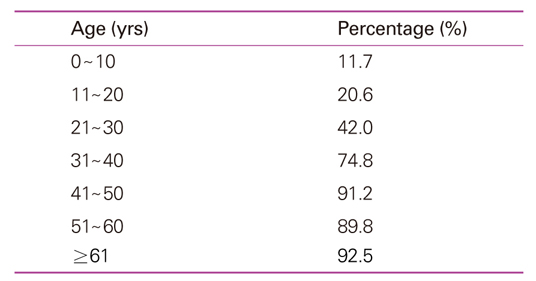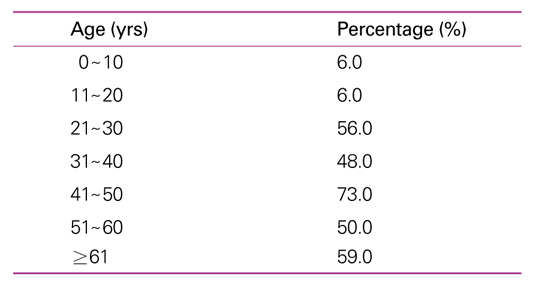 |
 |
- Search
| J Korean Med Assoc > Volume 51(2); 2008 > Article |
Abstract
The incidences of diphtheria and tetanus have been markedly reduced by the worldwide use of DTP vaccines. In Korea, tetanus outbreaks have disappeared since 1980s, and there has been no report on a patient with diphtheria since 1987. However, tetanus is still one of major health problems in many developing countries, and several serosurveillance studies in developed countries revealed that a substantial proportion of adult population may lack immunity against tetanus, and the immunity level against tetanus is continuously decreasing by age. In fact, few patients with tetanus have been reported since 1990s, and the immunity to tetanus is dramatically decreased in age groups over 30 years in our country. Also, persistent outbreaks of diphtheria in developing and developed countries have been reported. Many studies indicate that diphtheria outbreaks may occur under circumstances of ineffective immunization. In Korea, a few studies have reported that the diphtheria antibody titers in the 20~50 year age groups sharply decreased. Many studies confirmed that vaccine-induced immunity against tetanus and diphtheria did not last throughout the life, and serosurveillance studies suggested the existence of a large pool of susceptible individuals with a potential for epidemic infection. These results indicate that the Td vaccination program in adolescents and adults should be considered for maintenance of tetanus and diphtheria immunity.
References
1. Williams WW, Hikson MA, Kane MA, Kendal AP, Spika JS, Hinman AR. Immunization policies and vaccine coverage among adults; the missed opportunities. Ann Intern Med 1988;108:616-625.
2. Centers for Diseases Control. Impact of missed opportunities to vaccinate preschool aged children on vaccination coverage levels. MMWR 1994;43:709-718.
3. Vetter RT, Johnson GM. Vaccination update. Vaccines 1995;98:1433-1449.
4. Prevots R, Sutter RW, Strebel PM, Cochi SL, Hadler S. Tetanus surveillance, United States, 1989-1990. MMWR (CDC Surveill Summ) 1992;41:1-9.
5. Gergen PJ, McQuillan GM, Kiely M, Ezzati-Rice TM, Sutter RW, Virella G. A population based serologic survey of immunity to tetanus in the United States. N Engl J Med 1995;332:761-766.
6. Christenson B, Bottiger M. Epidemiology and immunity to tetanus in Sweden. Scand J Infect Dis 1987;19:429-435.
7. Stark K, Schonfeld C, Barg J, Molz B, Vornwald A, Bienzle U. Seroprevalence and determinants of diphtheria, tetanus and poliomyelitis antibodies among adults in Berlin, Germany. Vaccine 1999;17:844-850.
8. Shin DH, Yu HS, Park JH, Shin JH, Kim SJ. Recently occurring adult tetanus in Korea: emphasis on immunization and awareness of tetanus. J Korean Med Sci 2003;18:11-16.
9. Svensson A, Bottiger M, Gustavsson O. Immunity in the Swedish population: diphtheria, tetanus and poliomyelitis. Intern J Epidemiol 1998;27:909-915.
10. Rix BA, Zhobakas A, Wachmann CH, Bakasenas V, Ronne T. Immuity from diphtheria, tetanus, poliomyelitis, measles, mumps and rubella among adults in Luthuania. Scand J Infect Dis 1994;26:459-467.
11. Kang JH, Hur JK, Kim JH, Lee KI, Park SE, Ma SH, Lee MS, Ban SJ, Hong SH, Cho DH, Lee SH. Age related serosurvey of immunity to tetanus in Korean population. Korean J Infect Dis 2001;33:104-111.
12. Bottiger Margareta, Gustavsson O, Svensson A. Immunity to tetanus, diphtheria and poliomyelitis in the adult population of Swedish in 1991. Intern J Epidemiol 1998;27:916-925.
13. Weiss BP, Strassburg MA, Feeley JC. Tetanus and diphtheria immunity in an elderly population in Los Angeles County. Am J Public Health 1983;73:802-804.
14. Goncalves G, Santos MA, Cutts FT, Barros H. Susceptibility to tetanus and missed vaccination opportunities in Portuguese women. Vaccines 1999;17:1820-1825.
15. Brair ME, Brabin BJ, Milligan P, Maxwell S, Hart CA. Reduced transfer of tetanus antibodies with placental malaria. Lancet 1994;343:208-209.
16. Goldsmith S, Rosenberg E, Pollaczek EH. A study of the antibody response to a booster dose of tetanus toxoid. N Engl J Med 1967;267:485-487.
17. Abacioglu YH, Eskisar T, Yulug N. Concentration and avidity of antitetanus antibodies in mother-infant pairs; relation to immunization time. FEMS Immunology and Medical Microbiology 1995;11:273-278.
18. Galazka A, Gasse F. The present status of tetanus and tetanus vaccination. Current topics in Microbiology & Immunology 1995;195:31-53.
19. Turner TB, Velasco-Joven EA, Prudovsky S. Studies on the prophylaxis and treatmenr of tetanus. Bull Johns Hopkins Hosp 1958;102:71-84.
20. Cain HD, Falco FG. Recurrent tetanus. Calif Med 1962;97:31-33.
21. Alagappan K, Rennie W, Kwiatkowski T, Falck J, Silverstone F, Silverman R. Seroprevalence of tetanus antibodies among adults older than 65 years. Annals of Emergency Medicine 1996;28:18-21.
22. General recommendations on immunization: recommendations of the ACIP. MMWR 1994;43:1-38.
23. Simonsen O, Badsberg JH, Kjeldsen K, Moller Madsen B, Heron I. The fall-off in serum concentration of tetanus antitoxin after primary and booster vaccination. Acta Pathol Microbiol Immunol Scand 1986;94:77-82.
24. Balestra DJ, Littenberg B. Should adult tetanus immunization be given as a single vaccination at age 65? A cost effectiveness analysis J Gen Intern Med 1993;8:405-412.
25. Perera VY, Corbel MJ. Human antibody to fragments A and B of diphtheria toxin and a synthetic peptide of amino acid residues 141-157 of fragment A. Epidemiol Infect 1990;105:457-468.
26. Immunization Practices Advisory Committee. Centers for Disease Control. Diphtheria, tetanus and pertussis. Guidelines for vaccine prophylaxis and other preventive measures. Ann Int Med 1981;95:723-728.
27. Expanded Programme on Immunization: Outbreak of diphtheria, update, Russian Federation. Wkly Epidemiol Rev 1993;8:134-138.
28. Dittmann S. The diphtheria situation in the Newly Independent States and the WHO/Unicef strategy to control diphtheria 1995;Presented at the WHO/UNICEF Satellite Meeting on Diphtheria Control in European Countries participating in MICACAR. 31 January-1 Feburary. Ankara, Turkey.
29. Lee DH. The past, present and future of nation immunization in Korea. Korean J Infect Dis 1995;27:213-219.
30. Yun YH, Park HJ, Yu SW, Kwon SB, Minn YK, Cho SJ, Kwon KH. A case of polyneuropathy suggesting diphtheritic neuropathy. J Korean Neurol Assoc 2005;23:288-289.
31. Galazka AM, Robertson SE. Immunization against diphtheria with special emphasis on immunization of adults. Vaccine 1996;14:845-847.
32. Christenson B, Bottiger M. Serological immunity to diphtheria in Sweden in 1978 and 1984. Scand J Infect Dis 1986;18:227-233.
33. Galazka A, Keja J. Diphtheria: Incidence trends and age-wise changes of immunity. Scand J Infect Dis 1988;20:355-356.
34. Cellesi C, Zanchi A, Michelangeli C, Giovannoni F, Sansoni A, Rossolini GM. Immunity to diphtheria in a sample of adult population from central Italy. Vaccine 1989;7:417-420.
35. Christenson B. Is diphtheria comming back? Ann Clin Res 1986;18:69-70.
36. Kwantes W. Diphtheria in Europe. J Hyg Camb 1984;93:433-437.
37. Maple PA, Efstratiou A, Geroge RC, Andrews NJ, Sesardic D. Diphtheria immunity in UK blood donors. Lancet 1995;345:963-965.
38. Khuri-Bulos N, Hamzah Y, Sammerrai SM, Shehabi A, Hamed R, Arnaout MA, Turk J, Qubain H. The changing epidemiology of diphtheria in Jordan. Bulletin of the WHO 1988;66:65-68.
39. Cellesi C, Zanchi A, MIchelangeli C, Giovannoni F, Sansoni A, Rossolini GM. Immunity to diphtheria in a sample of adult population from central Italy. Vaccine 1989;7:417-420.
40. Lee BK, Park JK, Yoo JI, Shin KH, Shon YM, Park KD, Lee CG, Kim JS. Serological immunity to diphtheria among Korean population. Korean J Infect Dis 1998;30:278-283.
41. Kang JH, Hur JK, Kim JH, Lee KI, Park SE, Ma SH, Lee MS, Bark SY, Hong SH, Min HK. Age related seroepidemiological study of diphtheria among Koreans. Korean J Infect Dis 2000;32:1-7.
42. Cellesi C, Michelangeli C, Rossoloni GM, Giovannoni F, Rossolini A. Immunity to diphtheria, six to 15 years after a basic three-dose immunization schedule. J Biol Stand 1989;17:29-34.
43. Ramsay MEB, Corbel MJ, Keith R, Ashworth LAE, Norman TB. Persistence of antibody after accelerated immunisation with diphtheria/tetanus/pertussis vaccine. BMJ 1991;302:1489-1491.
44. Golaz A, Hardy IR, Glushkevich TG, Areytchiuk EK, Deforest A, Strebel P, Wharton M, Sutter RW. Evaluation of a single dose of diphtheria-tetanus toxoids among adults in Odessa, Ukraine, 1995: immunogenicity and adverse reactions. J Infect Dis 2000;181:S203-S207.
45. Balestra DJ, Littenberg B. Should adult tetanus immunization be given as a single vaccination at age 65? A cost effectiveness analysis J Gen Intern Med 1993;8:405-412.
46. Bayas JM, Vilella A, Bertran MJ, Vidal J, Batalla J, Asenjo MA, Salleras LL. Immunogenicity and reactogenicity of the adult tetanus-diphtheria vaccine. How many doses are necessary? Epidemiol Infect 2001;127:451-460.
47. Sesardic D, Corbel MJ. Testing for neutralising potential of serum antibodies to tetanus and diphtheria toxin. Lancet 1992;340:737-738.
48. Southern J, Andrews N, Burrage M, Miller E. Immunogenicity and reactogenicity of combined acellular pertussis/tetanus/low dose diphtheria vaccines given as a bosster to UK teenagers. Vaccine 2005;31:3829-3835.
49. Kang JH, Lee SY, Kim HM, Park JS, Ma SH. The assessment of adult Td vaccine usefulness 2007;KFDA. 32-33.
50. Scheifele DW, Dobson S, Kallos A, Bjornson G, Ochnio JJ. Comparative safety of a tetanus-diphtheria toxoids booster immunization in students in Grade 6 and 9. Pediatr Infect Dis J 1998;17:1121-1126.
51. Vilella A, Dal-Ré R, Simó D, García-Corbeira P, Diego P, Bayas JM. Reactogenicity profile of tetanus-diphtheria (adult-type) vaccine: results of a naturalistic study performed at an adult vaccination center. J Clin Pharmacol 2000;40:1267-1273.
52. Michael EP, Mark MB, William AK, James H, Dominique D, Leonard RF. Acellualr pertussis vaccine booster combined with diphtheria and tetanus toxoids for adolescents. Pediatrics 2006;117:1084-1093.
53. Chan SH, Tan PT, Han HH, Bock HL. Immunogenicity and reactogenicity of a reducedantigen-content diphtheria-tetanus-acellular pertussis vaccine as a single-dose booster in Singaporean adults. Singapore Med J 2006;47:286-290.
54. Laroche P, Barrand M, Wood SC, Van Hasbrouck K, Lang J, Harzer E, Hessel L. The immunogenicity and safety of a new combined diphtheria, tetanus and poliomyelitis booster vaccine. Infection 1999;27:49-56.
- TOOLS










